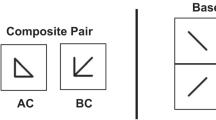Abstract
Deep convolutional neural networks (CNNs) are widely known for their outstanding performance in classification and regression tasks over high-dimensional data. This made them a popular and powerful tool for a large variety of applications in industry and academia. Recent publications show that seemingly easy classification tasks (for humans) can be very challenging for state of the art CNNs. An attempt to describe how humans perceive visual elements is given by the Gestalt principles. In this paper we evaluate AlexNet and GoogLeNet regarding their performance on classifying the correctness of the well known Kanizsa triangles and triangles where sections of the edges were removed. Both types heavily rely on the Gestalt principle of closure. Therefore we created various datasets containing valid as well as invalid variants of the described triangles. Our findings suggest that perceiving objects by utilizing the principle of closure is very challenging for the applied network architectures but they appear to adapt to the effect of closure.
Access this chapter
Tax calculation will be finalised at checkout
Purchases are for personal use only
Similar content being viewed by others
Notes
- 1.
In our case: Inception v3.
- 2.
30.000 training, 10.000 validation and 10.000 test images; dimension: \(256 \times 256\) px.
- 3.
To maximize the visual error, the offset is applied in the direction of the connecting line of the other two vertices.
- 4.
All CNNs were trained using NVIDIA DIGITS https://developer.nvidia.com/digits with the Torch backend and def. settings: fixed learning rate = 0.01, solver = SGD.
- 5.
While the original MNIST dataset contains 60.000 training images and 10.000 validation images, we moved 10.000 training images to a test image set, and deleted 20.000 of the training images while not changing the distribution of the images among the classes. We did this to be comparable with our own datasets.
- 6.
Trained multiple times; lowest results are displayed.
- 7.
In further experiments we also worked with a set where only one of the three vertices was rotated. AlexNet needed at least 109 epochs to be able to classify 95% correctly, while GoogLeNet needed 6 epochs.
References
Kim, B., Reif, E., Wattenberg, M., Bengio, S.: Do neural networks show gestalt phenomena? An exploration of the law of closure. arXiv preprint (2019)
Krizhevsky, A., Sutskever, I., Hinton, G.E.: Imagenet classification with deep convolutional neural networks. In: Advances in Neural Information Processing Systems (2012)
LeCun, Y., et al.: Backpropagation applied to handwritten zip code recognition. Neural Comput. 1(4), 541–551 (1989). https://doi.org/10.1162/neco.1989.1.4.541
LeCun, Y., Bottou, L., Bengio, Y., Haffner, P.: Gradient-based learning applied to document recognition. Proc. IEEE 86(11), 2278–2324 (1998). https://doi.org/10.1109/5.726791
Stabinger, S., Rodríguez-Sánchez, A., Piater, J.: 25 years of CNNs: can we compare to human abstraction capabilities? In: Villa, A.E.P., Masulli, P., Pons Rivero, A.J. (eds.) ICANN 2016. LNCS, vol. 9887, pp. 380–387. Springer, Cham (2016). https://doi.org/10.1007/978-3-319-44781-0_45
Stabinger, S., Rodríguez-Sánchez, A.: Evaluation of deep learning on an abstract image classification dataset. In: Proceedings of the IEEE International Conference on Computer Vision, pp. 2767–2772 (2017). https://doi.org/10.1109/iccvw.2017.325
Szegedy, C., et al.: Going deeper with convolutions. In: Proceedings of the IEEE Conference on Computer Vision and Pattern Recognition, pp. 1–9 (2015). https://doi.org/10.1109/cvpr.2015.7298594
Wertheimer, M.: Laws of organization in perceptual forms. In: A Source Book of Gestalt Psychology, pp. 71–88, London (1938). https://doi.org/10.1037/11496-005
Acknowledgment
We want to thank the anonymous reviewers for their constructive suggestions and helpful comments.
Author information
Authors and Affiliations
Corresponding author
Editor information
Editors and Affiliations
Rights and permissions
Copyright information
© 2019 Springer Nature Switzerland AG
About this paper
Cite this paper
Ehrensperger, G., Stabinger, S., Sánchez, A.R. (2019). Evaluating CNNs on the Gestalt Principle of Closure. In: Tetko, I., Kůrková, V., Karpov, P., Theis, F. (eds) Artificial Neural Networks and Machine Learning – ICANN 2019: Theoretical Neural Computation. ICANN 2019. Lecture Notes in Computer Science(), vol 11727. Springer, Cham. https://doi.org/10.1007/978-3-030-30487-4_23
Download citation
DOI: https://doi.org/10.1007/978-3-030-30487-4_23
Published:
Publisher Name: Springer, Cham
Print ISBN: 978-3-030-30486-7
Online ISBN: 978-3-030-30487-4
eBook Packages: Computer ScienceComputer Science (R0)




